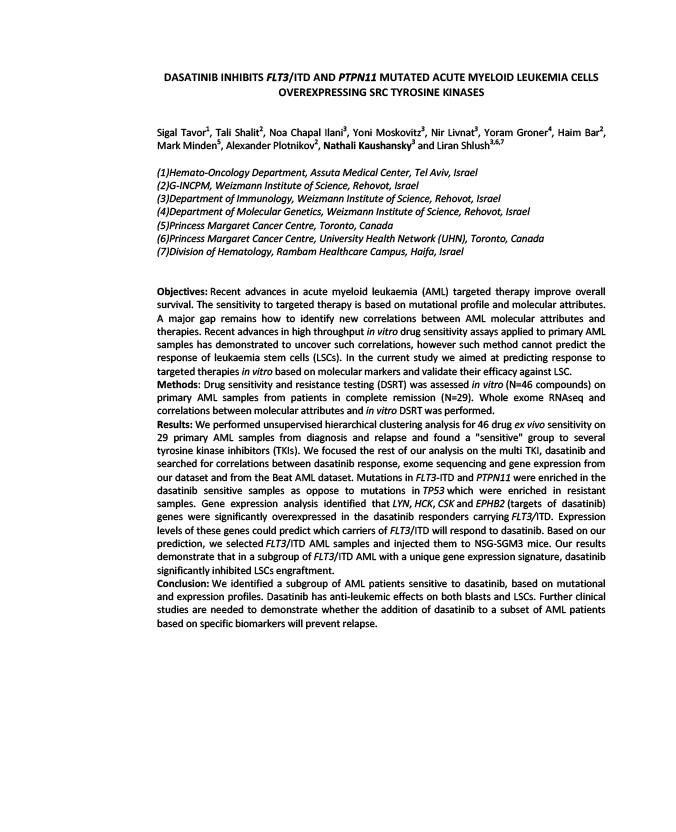
DASATINIB INHIBITS FLT3/ITD AND PTPN11 MUTATED ACUTE MYELOID LEUKEMIA CELLS
OVEREXPRESSING SRC TYROSINE KINASES
Sigal Tavor1, Tali Shalit2, Noa Chapal Ilani3, Yoni Moskovitz3, Nir Livnat3, Yoram Groner4, Haim Bar2,
Mark Minden5, Alexander Plotnikov2, Nathali Kaushansky3 and Liran Shlush3,6,7
(1)Hemato-Oncology Department, Assuta Medical Center, Tel Aviv, Israel
(2)G-INCPM, Weizmann Institute of Science, Rehovot, Israel
(3)Department of Immunology, Weizmann Institute of Science, Rehovot, Israel
(4)Department of Molecular Genetics, Weizmann Institute of Science, Rehovot, Israel
(5)Princess Margaret Cancer Centre, Toronto, Canada
(6)Princess Margaret Cancer Centre, University Health Network (UHN), Toronto, Canada
(7)Division of Hematology, Rambam Healthcare Campus, Haifa, Israel
Objectives: Recent advances in acute myeloid leukaemia (AML) targeted therapy improve overall
survival. The sensitivity to targeted therapy is based on mutational profile and molecular attributes.
A major gap remains how to identify new correlations between AML molecular attributes and
therapies. Recent advances in high throughput in vitro drug sensitivity assays applied to primary AML
samples has demonstrated to uncover such correlations, however such method cannot predict the
response of leukaemia stem cells (LSCs). In the current study we aimed at predicting response to
targeted therapies in vitro based on molecular markers and validate their efficacy against LSC.
Methods: Drug sensitivity and resistance testing (DSRT) was assessed in vitro (N=46 compounds) on
primary AML samples from patients in complete remission (N=29). Whole exome RNAseq and
correlations between molecular attributes and in vitro DSRT was performed.
Results: We performed unsupervised hierarchical clustering analysis for 46 drug ex vivo sensitivity on
29 primary AML samples from diagnosis and relapse and found a "sensitive" group to several
tyrosine kinase inhibitors (TKIs). We focused the rest of our analysis on the multi TKI, dasatinib and
searched for correlations between dasatinib response, exome sequencing and gene expression from
our dataset and from the Beat AML dataset. Mutations in FLT3-ITD and PTPN11 were enriched in the
dasatinib sensitive samples as oppose to mutations in TP53 which were enriched in resistant
samples. Gene expression analysis identified that LYN, HCK, CSK and EPHB2 (targets of dasatinib)
genes were significantly overexpressed in the dasatinib responders carrying FLT3/ITD. Expression
levels of these genes could predict which carriers of FLT3/ITD will respond to dasatinib. Based on our
prediction, we selected FLT3/ITD AML samples and injected them to NSG-SGM3 mice. Our results
demonstrate that in a subgroup of FLT3/ITD AML with a unique gene expression signature, dasatinib
significantly inhibited LSCs engraftment.
Conclusion: We identified a subgroup of AML patients sensitive to dasatinib, based on mutational
and expression profiles. Dasatinib has anti-leukemic effects on both blasts and LSCs. Further clinical
studies are needed to demonstrate whether the addition of dasatinib to a subset of AML patients
based on specific biomarkers will prevent relapse.